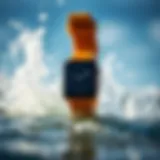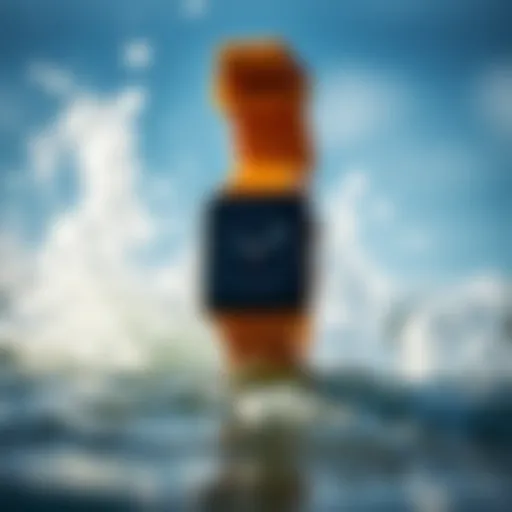Surfing the Wake: Techniques and Insights
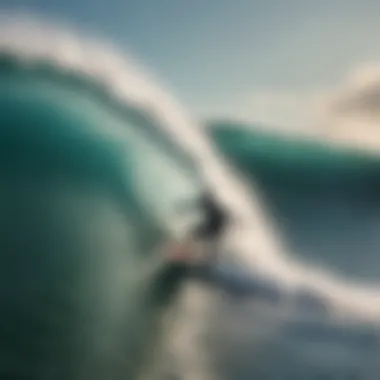

Intro
Surfing the wake of a boat stands as one of the more thrilling niches within the broad spectrum of water sports. Unlike traditional surfing, which relies solely on ocean waves, wake surfing transforms boat-generated waves into a canvas for skillful maneuvers and exhilarating experiences. It’s a unique harmony of physics and artistry—riding on the swell created by a powered vessel, adding a layer of depth to the otherwise peaceful waterfront. With an increasing number of enthusiasts diving headfirst into this captivating activity, the nuances of wake surfing are worth exploring.
The sheer freedom one experiences while gliding over these artificial waves offers a distinct blend of adrenaline and serenity. As the boat propels forward, it shapes the water into steep, curving swells perfect for catching and riding. However, to truly master this discipline, understanding surfboard technology, refining techniques, and valuing safety become essential components of the learning journey. This guide will unpack these elements, providing insights into the exhilarating world of wake surfing and what every enthusiast—be they novice or accomplished—should know to enhance their experience.
Surfboard Technology
The choice of surfboard plays a pivotal role in how one interacts with the waves generated by a boat. To those who are new to wake surfing, it can feel overwhelming yet exciting to navigate through the options available.
Innovations in Surfboard Materials
The surfboard industry has witnessed noteworthy advancements in materials over recent years. Traditionally, boards were crafted from fiberglass and foam, which, while effective, lacked in durability and performance consistency. Today, the emergence of high-tech composites, including carbon fiber and epoxy resins, has revolutionized surfboards, making them more lightweight and responsive—ideal for executing sharp turns and pop in the air.
An example to illustrate this is the difference between traditional polyurethane boards and modern epoxy boards. While poly boards tend to absorb water, adding extra weight, epoxy boards are less prone to such absorption, enabling enhanced buoyancy and speed.
Comparing Different Surfboard Shapes
Beyond materials, the shape of the surfboard can dramatically impact the experience of wake surfing. Boards come in various shapes—each designed with specific functionalities in mind.
- Shortboards offer agility and speed, perfect for performing tricks.
- Longboards provide stability and a smooth ride, appealing to beginners still learning the ropes.
- Wakesurf Boards, specifically designed for this type of surfing, typically have a wider tail and flatter rocker profile, helping riders maintain stability on the small waves.
In essence, selecting the right board based on personal skill level and riding style can elevate the entire wake surfing experience.
Surfing Techniques
Mastering wake surfing is not merely about choosing the right board; it also involves perfecting various techniques that cater to one’s skill set.
Essential Skills for Beginners
Beginning wake surfers often seek guidance on the basic skills required to effectively ride the wake. Starting with the fundamentals, here are several key practices:
- Grip: Learning how to hold the rope correctly and distribute your weight evenly on the board is critical for balance.
- Stance: Adopting a comfortable stance—usually shoulder-width apart—offers more control.
- Edge Management: Engaging the rail of the board against the water can help maneuver through wakes.
These foundational skills enable novices to feel more confident while on the water, laying the groundwork for advanced maneuvers.
Advanced Maneuvers for Experts
As surfers progress, they often crave more challenging tricks to elevate their game. There’s no shortage of advanced techniques ranging from ollies to spins.
- Shuvits involve popping the board off the water and rotating it, while keeping the rider intact on top.
- Frontside and Backside Spins push surfers to execute a full 360-degree turn.
- Air Tricks require great timing and board control to catch air off the wake and perform maneuvers mid-flight.
These advanced techniques require dedicated practice and often appear daunting; however, consistent training will inevitably lead to success.
Intro to Boat Wake Surfing
Boat wake surfing isn’t just a sport; it’s a synthesis of physics, art, and the thrill that comes from riding the wake behind a vessel. As more people discover the joys of gliding over the water, the significance of understanding this unique discipline becomes crystal clear. Not only does it enhance one's enjoyment of water sports, but it also cultivates a deeper connection with the environment and the mechanics at play during the experience.
Defining Wake Surfing
So, what is wake surfing really? At its core, wake surfing is about using the wave created by a boat to surf without being pulled by a rope. Unlike traditional surfing, where the rider needs to catch a wave, wake surfers harness the artificial wake generated by a boat moving through the water. This method allows surfers to ride in a much more controlled environment, making it accessible for individuals of various skill levels. The essence of this sport lies not just in standing on the board, but in maneuvering with finesse, balancing on the wave, and performing tricks effortlessly.
Moreover, what sets wake surfing apart are the smooth, rolling waves created by the tow boat, which differ significantly from oceanic waves. Many enthusiasts appreciate the different types of moves they can do, such as cutbacks, 360 spins, or even aerials, all of which add layers of excitement to the ride. As riders master the art of wave riding, understanding the dynamics also permits them to experiment further, enhancing both their skills and enjoyment.
The Evolution of Wake Surfing
Looking back, the roots of wake surfing aren’t too far from its more traditional surfing cousins, yet it has carved out its own identity over time. This unique discipline began to bloom in the early 2000s when innovative boat designs led to the creation of larger, more well-formed wakes. Specialized boats equipped with ballast systems altered the way waves were generated, allowing for ideal conditions that a surfer could thrive in.
Wake surfing's popularity has exploded in recent years, fueled by the growth of social media showcasing stunning visuals of surf sessions. Today, some passionate communities thrive on platforms like Reddit and Facebook, where surfers share tips, tricks, and experiences amidst vibrant discussions about the latest techniques and gear.
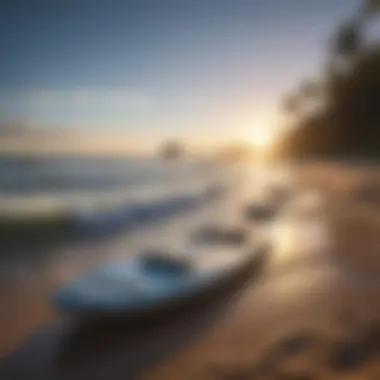

By accommodating both veterans and novices, wake surfing has transitioned into a community-driven sport that encourages participation and engagement. The evolution continues with innovations in board technology and growing awareness surrounding boat wakes' environmental impacts, paving the way for a more sustainable approach as the sport gains traction.
"Wake surfing is more than a pastime; it’s a way to connect with water and community, mixing thrill with mindfulness."
– A Perspective from the Wake Surfing Community
In summary, understanding boat wake surfing not only enriches the experience but also encourages a holistic approach to the sport. Whether for leisure or honing one's skills, it is essential for aspiring wake surfers to grasp the intricacies defining this sport and appreciate its development over time.
Fundamentals of Wake Dynamics
Understanding wake dynamics is fundamental to mastering the art of wake surfing. This section serves as a crucial bridge between theory and practice. The nuances of how wakes are formed and the characteristics they exhibit can either make or break a successful surfing experience.
Understanding Wake Formation
The wake produced by a boat isn’t merely a random disturbance in the water. It’s a complex intermingling of forces dictated by the boat's speed, shape, and the water's surface conditions. When a boat moves through water, it displaces a volume of water equal to its hull. As it glides along, waves are generated due to this displacement. This phenomenon creates a trailing wake that surfers can ride.
A few aspects to consider regarding wake formation include:
- Speed of the Boat: The faster the boat goes, the steeper the waves, but there's a fine line here. If too fast, the wave might become choppy and harder to surf. Ideally, a speed range of about 10-12 mph works well for most wake surfers.
- Boat Design: Different boats produce different types of wakes. For instance, boats specifically designed for wakeboarding often have broader hulls that displace more water, generating a larger and cleaner wake.
- Water Conditions: Calm waters yield a smoother experience. Choppy water, influenced by external conditions like wind, can disrupt the quality of the wake, making it less enjoyable to surf.
Understanding these principles lets surfers work more effectively with the conditions, and ultimately enhances their performance.
Types of Wakes and Their Characteristics
The landscape of wakes isn't a one-size-fits-all scenario; there are various types of wakes, each with distinct characteristics.
- Clean Wakes: These are formed by boats with a clean hull that slides smoothly through the water. They typically exhibit a gradual slope and are easier to ride. Surfers favor these for performing tricks and maintaining balance.
- Steep Wakes: Common with high-speed vessels, steep wakes can provide a short, powerful ride. However, they may be trickier for beginners. The sharper incline may launch surfers upward but can also lead to quicker descents.
- Plowing Wakes: When a boat moves at lower speeds, it often creates a surfable displacement wave that’s less steep. These are great for those still finding their footing, allowing for a gradual introduction to maneuvers without the steep drop-offs.
- Surf Wakes: These are engineered for wake surfing, achieved by adjusting boat ballast and speed. They create prominent waves that can be ridden with minimal effort. The skilled surfer can utilize them for extended rides.
"Understanding the characteristics of different wakes one might encounter is akin to knowing the terrain before setting foot on it. It’s about reading the waves, feeling the dynamics beneath your feet."
In summary, mastering the fundamentals of wake dynamics is integral not just for enhancing one’s skills but also for ensuring safety and maximizing enjoyment. By grasping the essential principles of wake formation and the variety of wake types, surfers can elevate their experience on the water.
Essential Gear for Surfing the Wake
When it comes to wake surfing, having the right gear is as crucial as the skills you bring to the water. Not only does the right equipment enhance your performance, but it also contributes significantly to safety and enjoyment. The gear doesn't just serve a functional purpose; it elevates the overall experience and allows for more creativity on the board. From surfboards to accessories, understanding each piece of equipment can make all the difference.
Selecting the Right Surfboard
Choosing a surfboard is akin to picking the right shoe for a marathon; it significantly impacts your performance on the water. The right board balances several factors – size, shape, and fin setup. Typically, wake surfboards are shorter and broader than traditional surfboards, ideal for riding the smaller waves created by the boat’s wake.
Key Considerations:
- Length: A board that is too long can hinder maneuverability, while one that is too short might not provide enough stability. Generally, boards range from 4 to 6 feet, and your height and weight should dictate your choice.
- Shape: A wider nose often provides better buoyancy, which is essential when catching the wave. Squash tails offer a good balance of speed and control, making them a popular choice among newcomers and veterans alike.
- Material: Most boards are made of epoxy or fiberglass. Epoxy boards are lighter and offer more buoyancy but tend to be less durable than fiberglass, which can handle the wear and tear of regular use.
- Fins: Fin configurations affect how the board reacts in the water. More fins can offer additional control during turns, while a single fin provides a looser feel. A lot of surfers prefer a thruster setup—three fins—as it strikes a nice balance.
Ultimately, it's worth testing different boards if you can. Each person's style and preferences differ, so a bit of trial and error can lead to the perfect match.
Additional Equipment and Accessories
Once you’ve got the surfboard sorted, don’t forget about the other essential gear that can enhance your wake surfing experience.
Must-Have Accessories:
- Wetsuit: Depending on the water temperature, a well-fitted wetsuit can keep you warm and provide some buoyancy. Look for one that fits snugly without being restrictive. Generally, consider a thicker suit for cooler waters.
- Life Jacket: A properly fitted life jacket tailored for wake surfers can provide that peace of mind, allowing you to focus on riding the wake. Look for lightweight options that allow for movement.
- Surf Rope: A surf rope helps you grab onto the boat's wake efficiently before popping up onto the board. Typically, these ropes have a shorter length than traditional wakeboarding ropes to help you maintain balance.
- Sunscreen: This one may seem simple, but protecting your skin is vital. Choose a waterproof sunscreen to avoid continuous reapplication; UV rays reflect off water, amplifying exposure.
- Towel and Change of Clothes: Even if you plan on spending a day on the water, having a towel and fresh clothes is always a good idea. It can be refreshing to dry off after a session and switch into something comfortable for downtime.
Epilogue
In essence, the right gear can make your wake surfing journey both safer and more enjoyable. From selecting the perfect board that suits your riding style, to ensuring you have the appropriate protective and comfort accessories, investing time in understanding gear selections is worth it. With the right setup, nothing will be able to stop you from riding those waves confidently and stylishly.
Techniques for Effective Wake Surfing
Surfing the wake of a boat requires more than just hopping on a board and paddling out. This section delves into the practical techniques that can take your wake surfing experience from basic to exhilarating. Mastering these methods not only maximizes enjoyment but also enhances safety, enabling surfers to ride the waves with confidence and style.
Starting on the Board
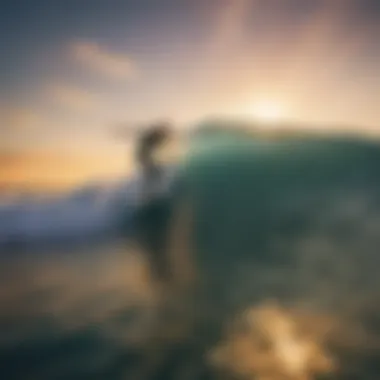

Getting on the board can feel a bit like launching into the deep end of a swimming pool; you've gotta be both bold and careful at the same time. To begin, find your position on the board while still in the water, usually with one foot on the tail and the other resting over the center area. This stable stance helps maintain equilibrium as the boat starts to move.
A common mistake is to overthink the initial push off. Here, timing is crucial: as the boat accelerates, use the moment to pull yourself up with your arms while shifting weight onto your feet. This dynamic motion gets you riding the wake almost immediately. Do this with confidence and keep your knees slightly bent to absorb any sudden jolts when the board hits the wake.
"A good start can make or break your ride. It sets the tone for the whole session."
Maintaining Balance and Control
Once you're up on the board, maintaining balance becomes the central task. Picture yourself as a tightrope walker; every subtle shift in weight can mean the difference between gliding smoothly or taking a tumble. Focus on keeping your center of gravity low, which involves bending your knees and leaning slightly forward. This stance not only helps control the board but also prepares you for any waves that might come your way.
Another essential tip is to keep your arms relaxed but engaged. Using your arms for balance provides extra stability. A common practice is to hold onto the handle tightly, but it's vital to avoid pulling it too hard. An excessive grip can lead to an unstable position and might throw off your balance.
Remember to read the wake too. The type of wake generated by the boat will greatly influence your riding. A larger wake demands faster reflexes and adjustments, while a smaller one might provide a smoother ride, allowing for more relaxed carving and tricks.
Performing Tricks and Maneuvers
Once you feel comfortable gliding with ease, the next step is to infuse some style into your ride. Tricks and maneuvers transform a simple surf session into a spectacle. Start with basic turns and small hops. These moves not only enhance your skill but also build confidence:
- Carving: Utilizing your edges to turn sharply can create beautiful arcs in the water.
- 180 Spins: With your legs bent, pivot your hips as you gently pull on the rope.
- Ollies: Push down on the tail of your board and pull up with your knees to get air.
As you gain more experience, consider incorporating more complex maneuvers, such as grabs or flips. Every trick requires a foundational understanding of balance, timing, and body control. Practice makes perfect, so don’t rush the process. Focus on nailing one trick at a time before moving on to the next; consistency will be your best friend.
Engaging with fellow surfers can also spark new ideas and offer invaluable tips. The surf community is robust with shared experiences and techniques that can help sharpen your skills.
Safety Considerations in Wake Surfing
When it comes to wake surfing, safety isn't just a footnote; it's the very backbone of the experience. Engaging with the power of a boat’s wake brings excitement, but it can also be fraught with risks. Whether you're a novice or a seasoned surfer, understanding the essential safety measures is paramount. Not only does this knowledge help prevent accidents, but it also enhances the overall enjoyment of your time on the water.
Pre-Surf Safety Checks
Before you dive into the exhilarating world of wake surfing, it's crucial to conduct thorough safety checks. Here are some key elements to consider:
- Inspect Equipment: Ensure your surfboard is free from cracks or damage. A faulty board can spell disaster when you’re on the water.
- Life Vests: Always wear a properly fitted life jacket. It’s a non-negotiable safety measure, regardless of your swimming ability.
- Boat Condition: Verify that the wake boat is functioning well. Check the engine, fuel levels, and navigation systems to avoid any mechanical issues while out on the water.
- Sufficient Rope Length: Make sure the tow rope used is not too short, which might throw you off balance.
- Communication Signals: Establish hand signals or a whistle system with your boat driver. Clear communication can prevent mishaps, especially when the engine noise makes verbal cues hard to hear.
By covering these aspects, you set the groundwork for a safe session.
Understanding Water Conditions
Water conditions can greatly influence the safety of wake surfing sessions. Familiarity with local waters can keep everyone in the group out of harm’s way. Here’s what to keep in mind:
- Current and Tide: Be aware of the strength of the current and any tidal changes. Underestimating these can lead to unexpected struggles.
- Wave Patterns: Learn how different boats create wakes. Not all wakes are the same—some may be gentler versus others that pack a punch.
- Visibility: Assess the visibility conditions. Fog or low-light settings can hinder your perceive ability and make navigation dangerous.
- Weather Conditions: Always check the forecast before heading out. Sudden storms can create chaos on the water, putting surfers at risk.
- Swimming Areas: Keep a safe distance from swimming zones to avoid collisions.
Staying informed about the water conditions not only safeguards your surfing experience but also respects others who share the water, ensuring everyone enjoys their time safely.
Overall, making safety a priority isn’t just about protecting yourself; it’s also about fostering a culture of safety within the wake surfing community. With the right preparations and awareness, you’ll find that the thrill of riding the wake can be enjoyed to its fullest.
Environmental Impact of Wake Surfing
Understanding the environmental impact of wake surfing is crucial in today's world, where the balance between enjoyment and sustainability is a pressing concern. This section delves into how wake surfing influences water bodies and outlines the necessity for promoting sustainable practices within the sport. As more individuals take to the waters, recognizing the ecological consequences becomes vital for preserving both marine ecosystems and the longevity of wake surfing as an activity.
Effects on Water Bodies
The effects of wake surfing on water bodies can range from subtle to significant, depending on various factors such as the size and type of boat, water depth, and local ecology. It's essential to take a closer look at the different influences:
- Erosion: Wake surfers can inadvertently contribute to shoreline erosion. The waves generated by boats can erode riverbanks and shorelines, especially in areas where vegetation has been removed to make way for recreational activities.
- Water Quality: Increased traffic from boats and surfers can lead to water pollution. Fuel spills, oil residue, and other contaminants can deteriorate water quality. It's important to be vigilant about using environmentally friendly equipment to reduce these harmful impacts.
- Wildlife Disruption: Wake surfing can disturb local wildlife, particularly in habitats that are crucial for spawning or nesting. Fish, birds, and other species may relocate due to the noise and physical disturbance created by the boat's wake.
By being aware of these consequences, wake surfers can adjust their practices.
"Every action has a ripple effect, both in surfing and in nature. We must ride the wave of responsibility."
Promoting Sustainable Practices
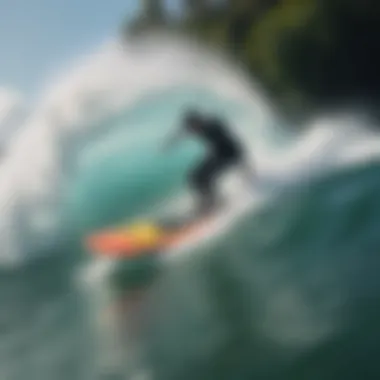

To ensure the future of wake surfing remains bright, it's essential to embrace sustainability. Here are some practical measures that surfers and boat owners can adopt:
- Tree Planting Initiatives: Replanting trees and vegetation along shorelines can help combat erosion and create natural barriers. This not only protects the banks but also improves the habitat for local wildlife.
- Choosing the Right Equipment: Opt for low-wake boats that minimize disruption to the environment. These boats yield smaller and less damaging wakes compared to traditional counterparts.
- Education and Awareness: A community effort to educate fellow enthusiasts about the impact of their activities is crucial. Sharing knowledge about water safety, conservation efforts, and eco-friendly practices can create a wave of change.
- Volunteering for Clean-Ups: Participate in local waterway clean-up days or support organizations that dedicate time and resources to keeping waterways clean and safe for all.
Integrating these sustainable practices can lead to a more conscientious culture around wake surfing. This evolution not only benefits the environment but also enhances the overall experience for surfers, ensuring they can enjoy the waves for years to come.
Cultural Significance of Wake Surfing
Wake surfing is more than just a thrilling water sport. It embodies a culture, a sense of belonging, and a lifestyle for many enthusiasts around the globe. This section delves into the various dimensions that contribute to the cultural importance of wake surfing, highlighting not only the sport itself but also the communities and traditions that have sprung up around it.
Historical Context and Development
The roots of wake surfing can be traced back to the 1950s when spirited surfers began using motorboats to create waves suitable for ride. As time rolled forward, this practice evolved and gained traction. By the late 1990s, wake surfing emerged as a formalized sport with its own set of rules and competition structures.
During this journey, various innovations shaped how wake surfing is perceived today. Early boards were often homemade or repurposed surfboards, but today’s market features highly specialized boards tailored for optimal performance on boat wakes. Understanding this evolution is critical, as it frames wake surfing not merely as a recreational activity but as a testament to human creativity and the endless pursuit of fun on water.
Community and Social Aspects
The social fabric of wake surfing is tightly woven with camaraderie and shared experiences. Local clubs and chapters often form around this sport, giving rise to vibrant communities where individuals exchange tips, connect over shark stories, and celebrate new talents.
Taking a boat out with friends quickly becomes a rite of passage, deepening friendships and sometimes forming lifelong bonds. These gatherings often blend a picnic atmosphere with competitive spirit, where moments of triumph are shared, high fives abound, and the thrill of riding the waves creates an unmistakable bond.
A significant part of this culture is welcoming newcomers. Experienced surfers often take it upon themselves to mentor novices, fostering a sense of inclusiveness. Such dynamics empower everyone -- from the rookie learning to balance to the seasoned pro nailing that backflip off the wake.
In any community, growth happens best when we support one another. Wake surfing embodies that quite literally as we carve our paths on the water together.
Furthermore, social media platforms like Instagram and Reddit play an integral role in connecting wake surfers worldwide. Individuals share moments, tricks, and accomplishments, inspiring each other daily. The hashtag culture related to wake surfing has even spawned global challenges that encourage surfers to showcase their skills and creativity.
As wake surfing continues to grow, it fosters a global community rooted in shared love for adventure and the water. The importance of belonging in such a community enhances the overall experience, allowing surfers to ride the waves together, breaking down geographical barriers while establishing a richly textured cultural fabric.
Expert Insights and Personal Experiences
Understanding expert insights and personal experiences is crucial in any sport, and wake surfing is no exception. This aspect not only bridges the gap between theory and practice, but it also offers an opportunity to learn from those who have navigated the waves of this exhilarating sport. Engaging with seasoned wake surfers provides invaluable information about the subtleties of technique, equipment preferences, and environmental conditions—elements that can make or break a session out on the water.
Interviews with Professional Wake Surfers
Interviews with professional wake surfers can shed light on various skills and mindsets essential for excelling in this discipline. Profiles of accomplished surfers often reflect diverse backgrounds while sharing common threads; the passion for the water and an unyielding will to improve. For instance, take the words of a seasoned surfer,
"Every time I hit the water, I learn something new. There's always that little technique tweak or a different stance to try," says Jenna, a local pro. "It's not just about tricks; it’s about feeling the water and adapting."
This echoes a sentiment often felt among professionals: the constant evolution in techniques, equipment adjustments, and personal growth transforms wake surfing into a lifestyle rather than merely a hobby.
Moreover, these interviews often delve into personal stories that reveal the emotional connection to the sport. For many surfers, waking up early to catch the best wave, spending hours on the boat with friends and family, or pushing limits during competitions are the essence of their wake surfing experience. Such insights humanize the sport and emphasize its community aspect, highlighting how it nurtures friendships and fosters bonds.
Lessons Learned from the Water
The lessons learned from time spent on the water are numerous and often profound. Many surfers discover that it is during the quiet moments of reflection, waiting for the perfect wave, that they gain clarity on both their surfing technique and their personal goals. There are several recurring lessons that surfers find valuable:
- Resilience: Surfing isn't always about dominance; sometimes, it's about persistence. There might be days filled with wipeouts before achieving that perfect ride. This journey teaches importance of getting back up, repacking, and trying again.
- Respect for Nature: The environment often throws unexpected challenges. Whether it's sudden changes in conditions or weather, adapting becomes key. This fosters a deep respect for water conditions and the natural world.
- Community Bonds: Learning to surf is often a shared journey. Friends and family may influence your progression, and the shared experiences create lasting memories. Friends encourage, provide tips, and celebrate each other’s successes.
In summary, diving into expert insights and personal experiences serves as a valuable resource for both new and seasoned surfers. The perspectives gained from professionals and the lessons learned on the water collectively enrich the wake surfing community, ensuring that each rider can navigate their path with a greater sense of purpose and understanding.
The Future of Wake Surfing
As the sport of wake surfing continues to grow, it's essential to look ahead and explore what the future holds. This section will delve into the innovations and evolving trends reshaping the landscape of wake surfing, not just for enthusiasts, but also for the environment and community. Understanding these aspects will be crucial for anyone involved in this thrilling discipline, from seasoned surfers to curious newcomers eager to ride the waves behind a boat.
Innovations in Equipment and Technology
Technology in wake surfing is evolving at a brisk pace. Manufacturers are continually researching and developing new gear that takes the performance to the next level. Equipment like weighted surf boats and advanced surfboards designed specifically for the sport are now common sights. This tech is not just about performance; it also addresses safety and comfort on the water.
- Smart Surfboards: One of the most fascinating developments is the rise of smart surfboards, which are integrated with sensors that help track performance metrics. Users can catch data regarding speed, tricks performed, and even balance, allowing them to refine their technique.
- Customizable Ballast Systems: Balancing the wake is key to a good ride. Newer boats now come with customizable ballast systems that let surfers adjust the size and shape of the wake to their liking. This tweakability means that every session can be uniquely catered to personal preferences.
- Eco-Friendly Materials: There's a growing emphasis on sustainability within the surf community. Companies are increasingly producing boards made from recycled materials or environmentally friendly composites. This shift suggests a broader awareness of environmental issues and a collective commitment to preserving our waterways.
Adopting these innovations not only enhances performance but also encourages a more sustainable approach to the sport. Maintaining connections with manufacturers and keeping an eye on emerging technologies will keep surfers at the cutting edge of wave riding.
Evolving Trends in Surf Culture
As wake surfing carves out its niche in the water sports community, some trends are emerging that shape how enthusiasts engage with the sport. Community dynamics and cultural shifts play a significant role in the evolution of wake surfing. Let's take a closer look.
- Inclusivity: One of the most noticeable trends is the push for inclusivity. Wake surfing is growing beyond traditional demographics. Events and competitions are now actively welcoming participants from varying skill levels, ages, and backgrounds. This evolution nurtures a grassroots approach, fostering camaraderie among all ocean lovers.
- Social Media Influence: The rise of social media has drastically altered how surfers connect. Platforms such as Facebook and Reddit offer spaces where surfers share tips and experiences, creating a sense of belonging and community. Video sharing sites have also allowed individuals to showcase their skills, attracting new participants to the sport.
- Environmental Awareness: Next, there's a palpable shift toward environmental consciousness within the community. Surfers are becoming more vocal about topics like pollution in water bodies and its impact on marine life. Events focused on clean-ups and educational sessions about environmental stewardship are picking up steam, signaling a cultural shift toward responsibility.
The future of wake surfing is not just about the tricks performed on the waves but also hinges on the attitude of the community.
In essence, keeping pace with the latest innovations, while also embracing the evolving culture, offers surfers the chance to shape a vibrant community that values both skill and responsibility. Looking toward the horizon, it’s clear that the future of wake surfing is as dynamic and thrilling as the sport itself.
